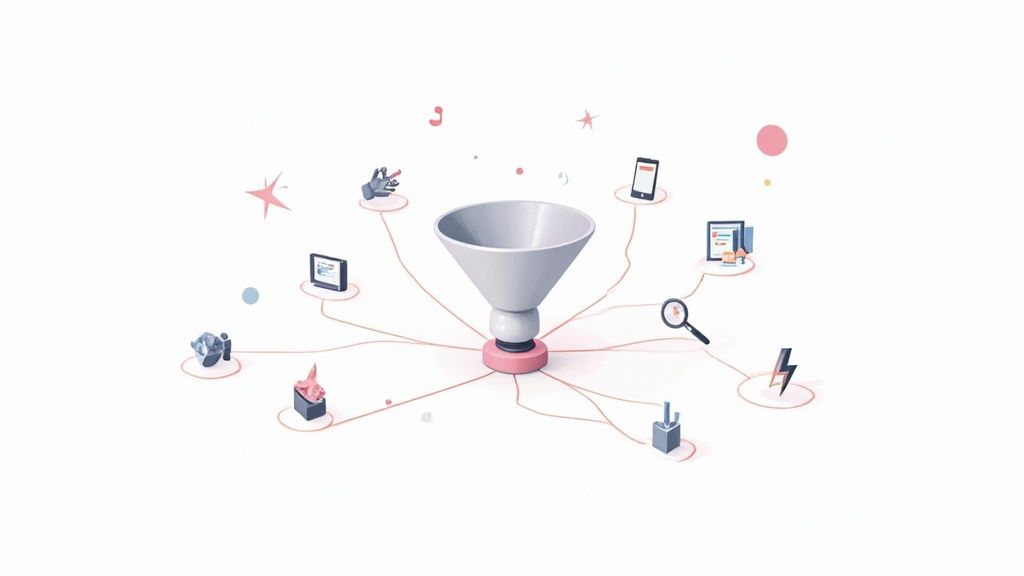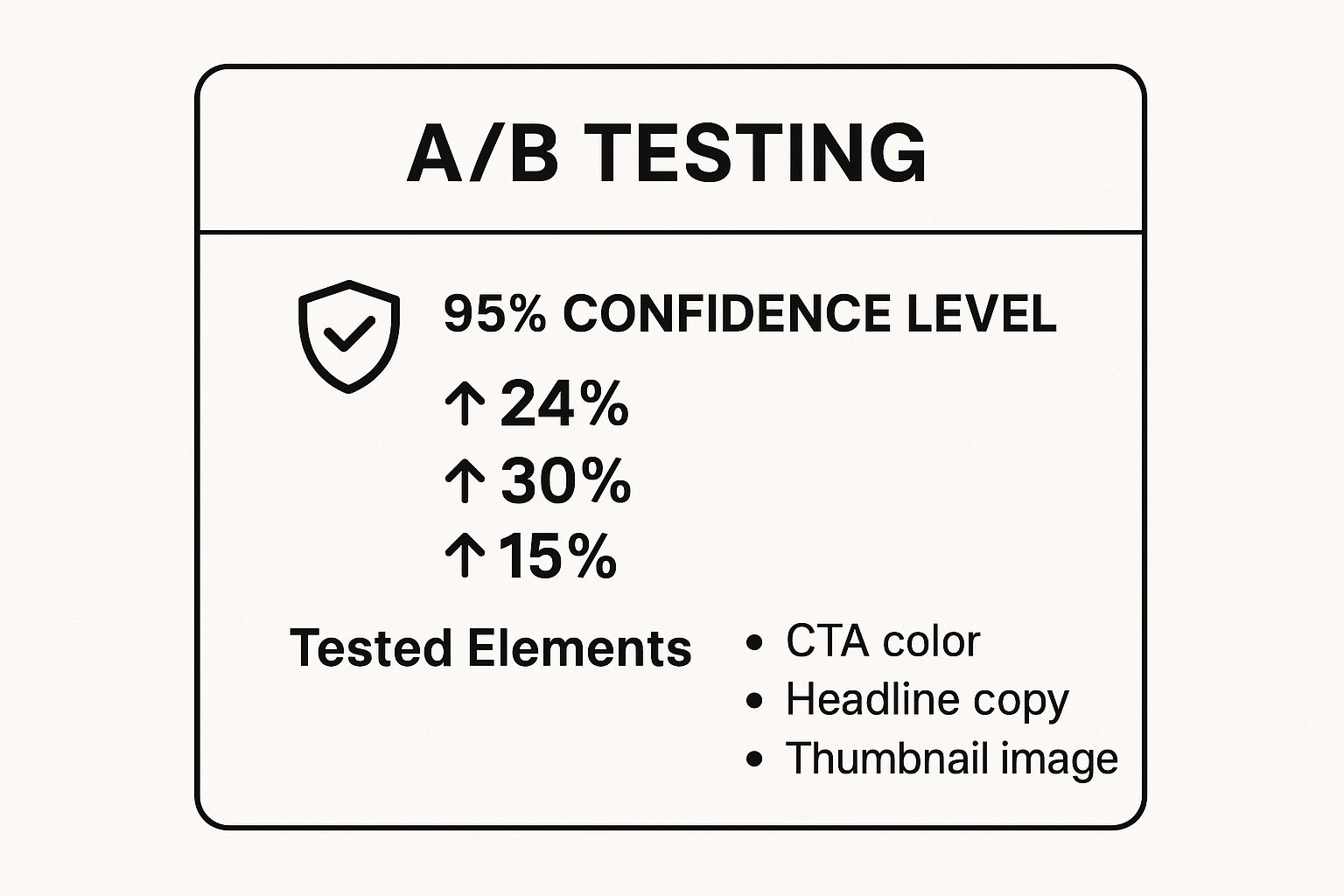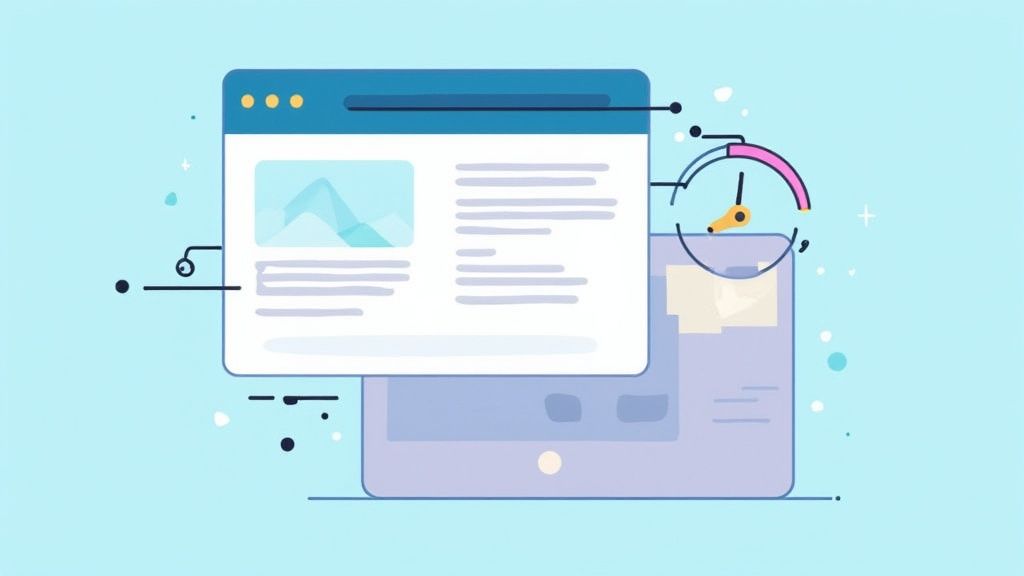8 High-Impact Conversion Rate Optimization Tips for 2025

In the competitive digital marketplace, attracting visitors is only half the battle. The real challenge lies in turning that traffic into meaningful actions: sales, sign-ups, and loyal customers. That's where Conversion Rate Optimization (CRO) comes in. It's the systematic process of enhancing your website and marketing to increase the percentage of visitors who complete a desired goal, a critical factor for sustainable growth.
This article moves beyond generic advice to provide a comprehensive roundup of powerful, data-backed conversion rate optimization tips you can implement today. We will dissect proven strategies ranging from meticulous A/B testing and compelling call-to-action design to advanced pricing psychology and trust signal implementation. Each tip is designed to provide clear, actionable steps and real-world examples to help you achieve measurable results and maximize your digital ROI.
We’ll cover everything from the technical aspects, like landing page speed, to the psychological nuances of user behavior. Think of this as your blueprint for turning clicks into customers. For additional straightforward tactics to boost your website's performance, explore these 5 Easy Ways To Improve Your Conversion Rate to supplement the deep-dive strategies ahead. Let's begin building a higher-converting experience for your audience.
1. A/B Testing for Data-Driven Decisions
Guesswork has no place in a high-performing marketing strategy. A/B testing, also known as split testing, is a foundational conversion rate optimization tip that replaces assumptions with hard data. This method involves creating two versions of a single marketing asset (like a webpage or an email) and showing them to two similarly sized audience segments to see which one performs better.
By making one isolated change between version A (the control) and version B (the variation), you can scientifically determine what resonates most with your audience. For example, HubSpot famously increased conversions by 24% simply by testing a red call-to-action (CTA) button against a green one. This data-driven approach allows you to make incremental improvements that compound into significant gains over time.
How to Implement A/B Testing Effectively
To get reliable results, your testing process must be structured. The goal is to isolate a variable and measure its direct impact on user behavior.
- Test One Element at a Time: To know what caused a change in conversions, only modify one element per test. This could be your headline, CTA button color, or a product image.
- Ensure Statistical Significance: Don't end a test prematurely. Use a sample size calculator to determine how many visitors you need and let the test run long enough (often a full business cycle) to gather meaningful data.
- Focus on High-Impact Pages: Prioritize testing on pages with high traffic but low conversion rates, such as your homepage, pricing page, or key landing pages.
The infographic below summarizes the impactful results you can achieve by testing specific, high-leverage elements on your pages.

As the data shows, simple changes to elements like headlines and CTAs can yield double-digit conversion lifts when validated through rigorous testing. For more in-depth insights into experimental design, consider how A/B testing specifically for landing pages can be applied. This disciplined methodology, popularized by platforms like Optimizely and VWO, is essential for any serious CRO effort.
2. Compelling Call-to-Action Optimization
Your call-to-action (CTA) is the most critical conversion element on any page; it's the gateway between a visitor and a desired action. Compelling CTA optimization is a vital conversion rate optimization tip because it directly asks for the conversion, turning passive readers into active leads or customers. This practice involves refining the copy, design, and placement of your buttons and links to make them irresistible.
Effective CTAs combine persuasive language with clear visual cues that guide users effortlessly toward the next step. For instance, Performable saw a 21% increase in clicks by changing its button text from the generic "Submit" to the value-driven "Get My Free Assessment." This simple change highlights the benefit for the user, dramatically improving its performance and demonstrating the power of thoughtful CTA design.

How to Implement Compelling CTA Optimization
To transform your CTAs into conversion powerhouses, you must focus on making them action-oriented, value-driven, and highly visible. The goal is to remove any friction or hesitation a user might feel.
- Use First-Person, Action-Oriented Language: Shift the perspective to the user. Instead of "Download Your Guide," test "Download My Guide." This small change creates a sense of ownership and has been shown to boost click-through rates.
- Create Strong Visual Contrast: Your CTA button should stand out from the rest of the page. Use a color that contrasts with your page's background but still fits your brand palette to draw the user's eye directly to the button.
- Focus on Value, Not Friction: The button text should communicate the benefit the user will receive. Replace vague words like "Submit" or "Click Here" with specific outcomes like "Get My Free Trial" or "Reserve My Spot."
By optimizing your CTAs, you provide a clear and persuasive path for users to follow, directly impacting your conversion rates. To dive deeper into the nuances of persuasive writing, discover more insights with this guide on copywriting for beginners. This approach, championed by industry leaders like HubSpot and Unbounce, is a high-leverage tactic for any CRO strategy.
3. Landing Page Speed Optimization
In today's fast-paced digital world, patience is a scarce commodity. Landing page speed optimization is a critical conversion rate optimization tip that focuses on reducing the time it takes for your page to load. A slow page frustrates users and can cause them to abandon your site before your message is even delivered. Studies consistently show that even a one-second delay can lead to a significant drop in conversions, directly impacting your bottom line.
Major brands have demonstrated the power of speed. Walmart, for instance, discovered that for every one-second improvement in page load time, conversions increased by a full 2%. Similarly, Mozilla increased download conversions by 15.4% after shaving 2.2 seconds off its landing pages. These examples underscore that a fast, responsive user experience is not just a technical goal but a core driver of marketing success.

How to Implement Landing Page Speed Optimization Effectively
Improving your page speed involves a series of technical adjustments designed to make your site lighter and faster for every visitor. The goal is to deliver a seamless experience that keeps users engaged from the moment they click.
- Aim for a Sub-3-Second Load Time: This is the benchmark for a good user experience. Use tools like Google PageSpeed Insights to analyze your current performance and get specific recommendations.
- Compress and Optimize Images: Large image files are a common cause of slow load times. Use tools to compress images without a noticeable loss in quality and serve them in modern formats like WebP.
- Minimize HTTP Requests: Each element on your page (scripts, images, CSS files) requires a separate request to the server. Combine CSS and JavaScript files to reduce the total number of requests.
- Implement Lazy Loading: Configure your site to only load images and media when they are about to enter the user's viewport. This prioritizes loading the most critical content first.
This focus on technical performance, popularized by analysis tools from Google, GTmetrix, and Pingdom, is a non-negotiable aspect of modern CRO. A faster landing page directly improves user satisfaction, which in turn boosts conversion rates and strengthens brand perception.
4. Mobile-First Design and Responsive Optimization
Ignoring mobile users is no longer an option. With over half of all web traffic originating from mobile devices, a mobile-first design philosophy is one of the most critical conversion rate optimization tips for modern businesses. This approach involves designing for the smallest screen first and then scaling up to larger devices, ensuring a seamless and intuitive experience for the majority of your audience.
By prioritizing the mobile experience, you address constraints like smaller screen real estate and slower connection speeds from the outset. This forces you to focus on core functionality and content, resulting in a cleaner, more efficient design for all users. For instance, O'Neill Clothing saw a 65% increase in mobile conversions and a 101% boost in mobile revenue after implementing a responsive, mobile-first design. This strategy, championed by experts like Luke Wroblewski, directly supports Google's mobile-first indexing, impacting both usability and search visibility.
How to Implement Mobile-First Design Effectively
A successful mobile-first strategy goes beyond simply shrinking your desktop site. It requires a thoughtful approach to layout, navigation, and user interaction on smaller screens.
- Design for Thumb Navigation: Place key interactive elements like CTAs and menu buttons within the "thumb-friendly zone" at the bottom and center of the screen.
- Simplify Forms and Inputs: Use single-column layouts for forms and leverage mobile-friendly input types (like
telfor phone numbers oremailfor email addresses) to make data entry easier. - Prioritize Content Hierarchy: On a small screen, you must present the most important information first. Start with a compelling headline, a clear value proposition, and a prominent call-to-action above the fold.
- Optimize for Speed and Performance: Compress images and minify code to ensure your site loads quickly on mobile networks. Fast-loading pages are crucial for retaining visitor attention and driving conversions.
By building from the mobile experience up, you ensure your site is accessible, fast, and easy to use for every visitor, regardless of their device. Frameworks like Bootstrap have made adopting responsive design patterns more accessible than ever, making this a non-negotiable step in any CRO plan.
5. Social Proof and Trust Signal Implementation
Uncertainty is a major conversion killer. Social proof leverages a powerful psychological principle: people follow the actions and opinions of others when making decisions. By strategically placing testimonials, reviews, user counts, and security badges, you reduce visitor anxiety and build the confidence needed to drive conversions.
This technique is one of the most effective conversion rate optimization tips because it outsources persuasion to your existing customers. For example, Basecamp prominently displays its customer count to showcase popularity, while Amazon’s extensive review system drives billions in revenue by providing user-generated validation. These signals assure new visitors that they are making a safe and smart choice.

How to Implement Social Proof Effectively
To be convincing, social proof must feel authentic and be placed where it has the most impact. The goal is to address a user's potential doubts at the exact moment they arise.
- Be Specific and Authentic: Use detailed testimonials that highlight specific benefits rather than generic praise. Including photos and names adds a layer of credibility.
- Use Numbers and Data: Quantifiable proof like "Trusted by 50,000+ users" or "4.8/5 stars from 2,100 reviews" is more impactful than vague statements.
- Place Strategically: Position social proof near key conversion points. Display customer logos on your homepage, testimonials near a "Sign Up" button, and trust badges like security seals directly within your payment forms.
This concept, heavily influenced by Dr. Robert Cialdini's work, is now a cornerstone of platforms like Trustpilot and real-time notification apps like UseProof. By demonstrating credibility, you can dramatically improve customer engagement and user confidence.
6. Simplified Form Design and Optimization
The form is often the final hurdle between a potential customer and a conversion. Simplified form design is a powerful conversion rate optimization tip that focuses on reducing friction at this critical stage. By minimizing fields, improving usability, and streamlining the data-entry process, you make it as easy as possible for users to complete their desired action.
Even minor obstacles can cause users to abandon a form. For example, Unbounce discovered that reducing the number of form fields from 11 to just 4 resulted in a staggering 120% increase in conversions. Similarly, Expedia famously generated an additional $12 million in annual profit by removing a single, non-essential "Company Name" field. These examples highlight how every piece of requested information adds cognitive load, and reducing it pays dividends.
How to Implement Simplified Form Design
Your goal is to make the form feel effortless and intuitive. This involves removing any unnecessary steps and guiding the user smoothly toward completion.
- Ask Only for What's Essential: Scrutinize every field. If you don't absolutely need the information for the initial conversion, don't ask for it. You can always gather more data later.
- Use a Single-Column Layout: Studies consistently show that single-column forms are easier for users to scan and complete, leading to higher completion rates than multi-column layouts.
- Implement Inline Validation: Provide real-time feedback as users fill out the form. Instantly flagging an incorrectly formatted email address is far more user-friendly than showing an error message after they hit "Submit."
- Use Descriptive Button Text: Replace generic text like "Submit" with value-oriented phrases that describe the outcome, such as "Get Your Free Quote" or "Download the Ebook."
Optimizing your forms is one of the highest-impact CRO activities you can undertake. This approach, championed by platforms like Unbounce and Formstack, directly addresses user motivation by making the final step to conversion as frictionless as possible.
7. Personalization and Targeted Messaging
Generic, one-size-fits-all marketing is no longer effective. Personalization is a powerful conversion rate optimization tip that involves tailoring website content, offers, and experiences to individual users based on their behavior, demographics, or other data points. This strategy makes each visitor feel seen and understood, increasing relevance and driving them closer to conversion.
When users see content that speaks directly to their needs, they are far more likely to engage. For instance, Amazon attributes a staggering 35% of its revenue to its recommendation engine, while Netflix's personalized suggestions drive 80% of all content watched. This level of customization transforms a passive browsing session into a guided, relevant user journey.
How to Implement Personalization Effectively
To get started, you don't need a massive data science team. You can begin with simple tactics and scale your efforts as you gather more insights and tools.
- Segment Your Audience: Group users based on meaningful criteria. Start with simple segments like new vs. returning visitors, geographic location, or the traffic source they came from (e.g., Google search vs. a social media ad).
- Tailor Content and Offers: Show different headlines, images, or call-to-action buttons to different segments. For example, you can display a special offer to first-time visitors or show recently viewed items to returning customers.
- Use Behavioral Triggers: Personalize experiences based on real-time user actions. If a user has items in their cart, you can trigger a personalized exit-intent popup with a discount code to prevent abandonment.
The goal is to create a more relevant and streamlined path to purchase for every user. For a deeper dive into understanding the user groups you're targeting, you can learn more about conducting a target audience analysis to inform your strategy. This approach, championed by platforms like Dynamic Yield and Adobe Target, is a cornerstone of modern CRO.
8. Strategic Pricing Psychology and Presentation
How you price your product is just as important as the price itself. Strategic pricing psychology is a powerful conversion rate optimization tip that uses cognitive biases to frame your prices in a way that maximizes perceived value and encourages purchasing decisions. It moves beyond simple cost-plus models to consider how customers emotionally and psychologically react to different pricing structures.
The core idea is that customers don't evaluate prices in a vacuum; they use context, comparisons, and mental shortcuts to determine if an offer is a "good deal." For instance, restaurants have long used charm pricing ($9.99 instead of $10.00) because the left-most digit anchors perception, making the price seem significantly lower. By understanding and applying these principles, you can guide users toward the choices you want them to make and reduce friction at the point of sale.
How to Implement Pricing Psychology Effectively
To successfully leverage these techniques, you must present your pricing in a structured way that influences customer perception and boosts confidence in their purchase.
- Implement Price Anchoring: Always present your most expensive or premium option first. This sets a high-price "anchor," making subsequent, lower-priced options appear more reasonable and affordable in comparison.
- Use Charm Pricing and Decoys: End prices with a 9 or .99 for non-luxury goods to make them seem cheaper. Introduce a "decoy" option that is priced slightly lower than your preferred option but offers significantly less value, making your target package look like an obvious bargain.
- Frame Discounts Strategically: For lower-priced items, show the discount as a percentage ("50% off"). For higher-priced items, show the absolute monetary savings ("$200 off"). This maximizes the perceived value of the discount in each scenario.
This approach, popularized by behavioral economists like Dan Ariely, author of Predictably Irrational, focuses on how people actually make decisions, not how they theoretically should. When applied correctly, these small adjustments in presentation can lead to significant uplifts in sales and revenue.
Conversion Rate Optimization Tips Comparison
| Strategy | Implementation Complexity 🔄 | Resource Requirements ⚡ | Expected Outcomes 📊 | Ideal Use Cases 💡 | Key Advantages ⭐ |
|---|---|---|---|---|---|
| A/B Testing for Data-Driven Decisions | Medium to High (statistical setup, monitoring) | Moderate (traffic volume, tools) | Measurable conversion lifts, data-driven insights | Optimization of specific page elements with sufficient traffic | Reduces guesswork, continuous improvement, measurable ROI |
| Compelling Call-to-Action Optimization | Low to Medium (copywriting & design tweaks) | Low to Moderate (design resources) | Immediate conversion improvements | Enhancing user actions on key CTAs | Quick impact, easy to implement, cost-effective |
| Landing Page Speed Optimization | Medium to High (technical expertise needed) | Moderate to High (developer time, tools) | Improved conversion rates, SEO boost, user experience | Sites with slow load times, high bounce rates | Direct conversion correlation, SEO benefits, cost savings |
| Mobile-First Design and Responsive Optimization | High (redesign, multi-device testing) | High (design, testing across devices) | Increased mobile conversions, better UX | Mobile traffic dominant sites | Captures growing mobile users, better SEO and UX |
| Social Proof and Trust Signal Implementation | Low to Medium (content creation & placement) | Low to Moderate (testimonial gathering) | Increased trust and conversion rates | E-commerce, service signups, trust-building | Builds credibility, reduces anxiety, easy to implement |
| Simplified Form Design and Optimization | Low to Medium (form redesign and validation) | Low to Moderate (UX/UI effort) | Higher form completion and lead quality | Lead capture forms, checkout processes | Reduces friction, improves data quality, boosts conversions |
| Personalization and Targeted Messaging | High (data collection and dynamic content) | High (tech stack, data analytics) | Higher engagement and conversion | Websites with varying user segments | Significantly boosts relevance and conversion |
| Strategic Pricing Psychology and Presentation | Medium (pricing strategy and testing) | Moderate (marketing and design input) | Increased purchase likelihood | Pricing pages, SaaS, retail | Influences buying behavior, easy to test, broad applicability |
From Insight to Impact: Start Optimizing Today
The path to a higher conversion rate is not a destination; it's a continuous cycle of learning, testing, and adapting. We've explored eight powerful conversion rate optimization tips, each serving as a critical lever you can pull to transform user interest into meaningful action. From the empirical certainty of A/B testing to the subtle influence of pricing psychology, these strategies form a comprehensive framework for growth.
Remember, optimization is not about guesswork. It’s about building a deep, empathetic understanding of your audience. When you optimize your landing page speed, you're not just improving a metric; you're respecting your visitor's time. When you simplify a form, you're removing friction and frustration from their journey. Each adjustment, guided by data and user behavior, is a step toward creating a more seamless, intuitive, and persuasive digital experience.
Your Actionable Roadmap to Higher Conversions
The most significant barrier to conversion rate optimization is often inertia. To overcome this, focus on implementing one or two of these strategies immediately. Don't feel pressured to overhaul everything at once. Small, incremental changes are the foundation of sustainable success.
Here is a practical way to begin your optimization journey:
- Start with a Single Hypothesis: Choose one area that you believe holds the most potential. Is your call-to-action unclear? Is your mobile experience clumsy? Form a clear hypothesis, such as, "Changing our CTA button color from grey to orange will increase clicks by 15%."
- Implement and Test Rigorously: Use A/B testing tools to validate your hypothesis with real user data. Let the numbers guide your decisions, not your assumptions.
- Analyze, Learn, and Iterate: Whether your test succeeds or fails, you gain invaluable insight. Use that knowledge to inform your next hypothesis and repeat the process. This iterative loop is the engine of effective CRO.
Mastering these conversion rate optimization tips will do more than just boost your metrics; it will fundamentally shift your business focus toward a customer-centric model. By prioritizing the user experience, you not only increase sales and sign-ups but also build lasting trust and loyalty. Each successful optimization reinforces your brand's commitment to delivering value, creating a powerful competitive advantage that is difficult to replicate. The journey from insight to impact begins with a single, decisive step. Take that step today.
Ready to elevate your social media content and drive more conversions? Lumeo helps you transform static images and text into dynamic, engaging carousels that capture attention and guide users toward your call-to-action. Start creating high-impact content that converts by visiting Lumeo today.